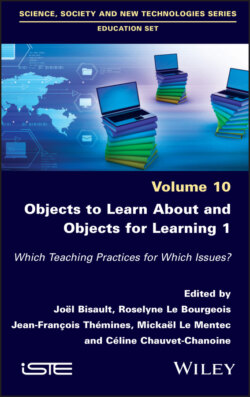Читать книгу Objects to Learn about and Objects for Learning 1 - Группа авторов - Страница 24
I.2.1. Objects, artifacts, instruments
ОглавлениеThere are many uses for the concept of the object. Most of the contributions to this publication express the need to qualify these objects with adjectives or nouns: transitional objects, mediating objects, hybrid objects, technical objects, didactic objects, oral objects, graphic objects, concrete objects, complex objects, target objects, shared attention objects, real objects, inducing objects, material objects, linguistic objects, semiotic objects, symbolic objects, didactic interface objects between teachers and pupils, cultural objects, original objects and so on.
In this list, it is important to differentiate between state or status designations and functional designations.
Concrete objects, whether technical, complex, real, material, manipulable, tangible, linguistic, semiotic, symbolic, cultural, etc., are thus qualified with the major oppositions between simple and compound (or complicated or complex), between actual and virtual, between real and symbolic, without their functions being specified. They are differentiated according to what they are, covering the material culture to which they belong. These are the school objects.
Conversely, transitional objects, mediators, inducers, interfaces, catalysts, etc., belong to a category distinguished by their function in the school environment. They are then didactic objects or pedagogical objects. They are at the service of teaching–learning as content resources or material for teachers and pupils. They are then schoolified and consequently desocialized, pretexts or accessories for school work.
By way of example, the train and its wagons made in kindergarten are the medium for learning to read diagrammatic instruction leaflets observing the order of the informational steps. This train then loses its customary function of transporting people or goods. In an even more distanced way, the train and its wagons represented by images become labels making it possible to identify the time and the days of the week. These translations are then sources of potential misunderstandings for the pupils who must notice this change of reference and mobilize the cognitive posture called for, sometimes implicitly.
Some articles in this book substitute artifacts or instruments for objects in order to extend the material world to symbolic or virtual things and in order to characterize a more anthropocentric approach highlighting the subjective appropriation of these things. In this regard, it is worth reiterating the contributions of Rabardel (1995) who first differentiated “technical objects” and “manufactured material objects” and then used the concept of “artifacts” by making reference to the definition in English. “The concept of the artifact refers in anthropology to anything that has undergone a transformation, even minimal, of human origin” (p. 59). With this anthropocentric perspective (as opposed to a technocentric vision), Rabardel characterizes the process of instrumental genesis. An instrument is thus both an artifact and the patterns associated with it:
In most conceptualizations it is the artifact that is considered explicitly or implicitly as an instrument. We propose to broaden this point of view and to consider the instrument as a mixed entity which is closely lined to both the subject and the artifact. In this perspective, the instrument includes: a material or symbolic artifact produced by the user or by others; one or more associated patterns of use resulting from a particular construction or the appropriation of pre-existing social patterns […] The combination of artifact and patterns constitutes the instrument. (Rabardel 1995, p. 11)
It is from this instrumental perspective that the objects for learning and the objects to learn about should be investigated.
